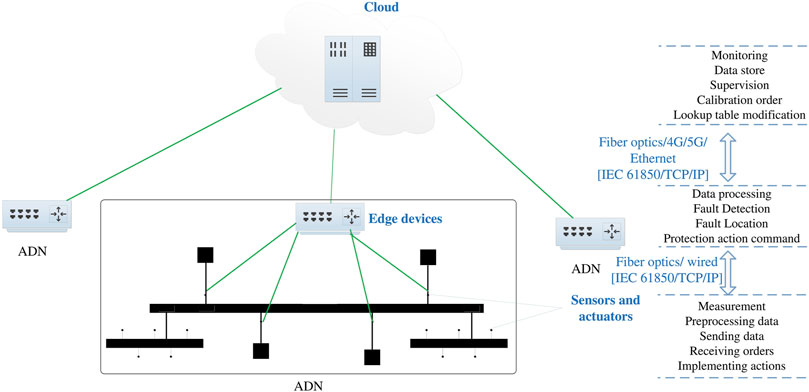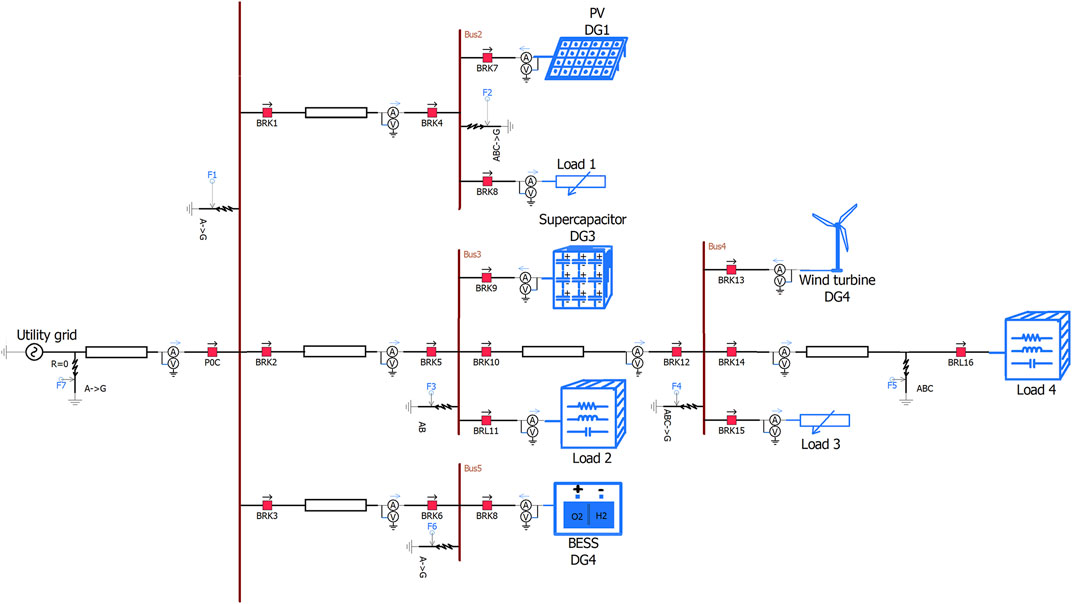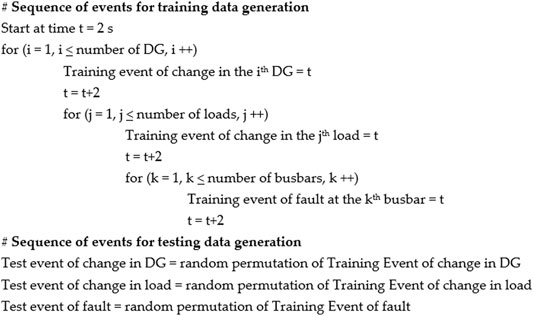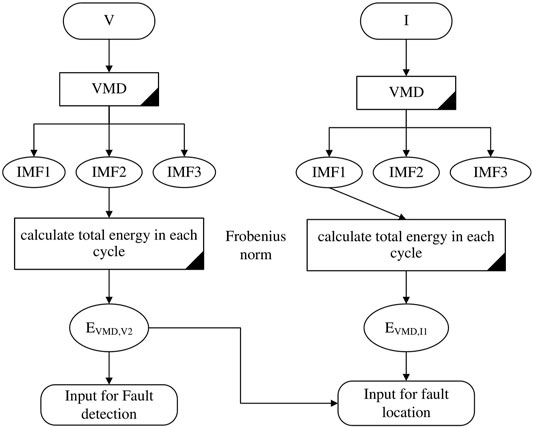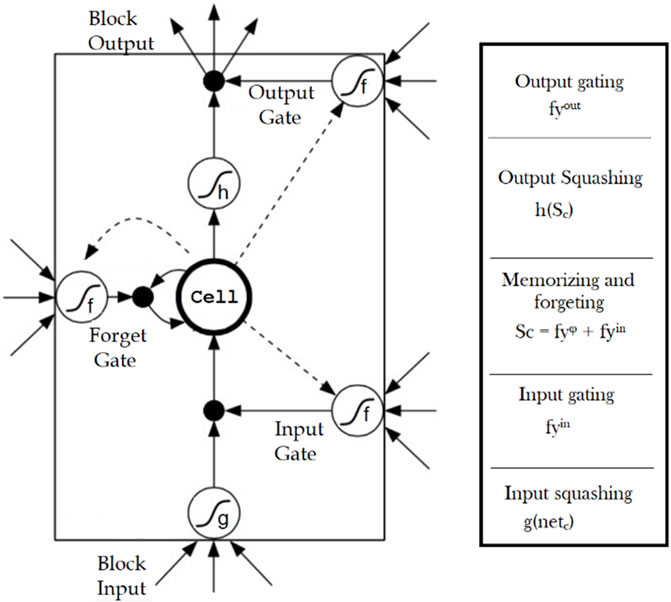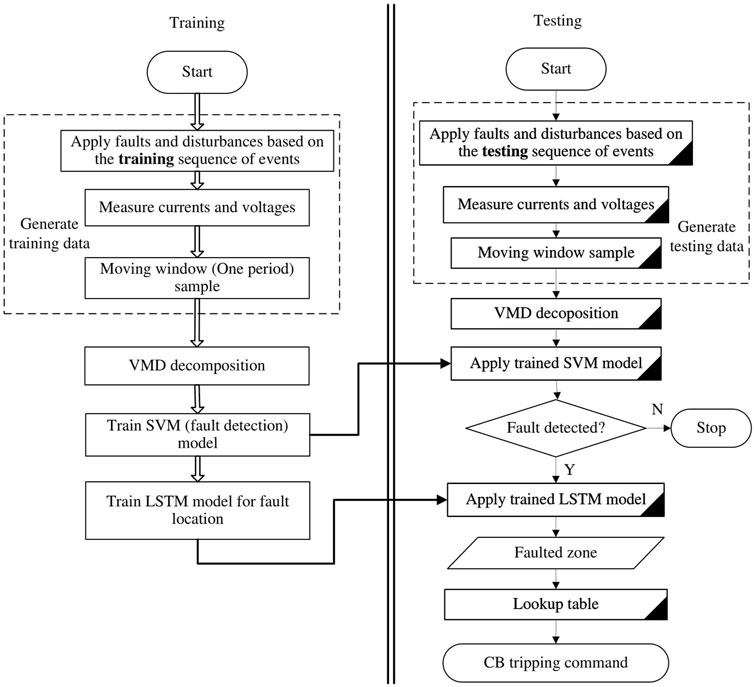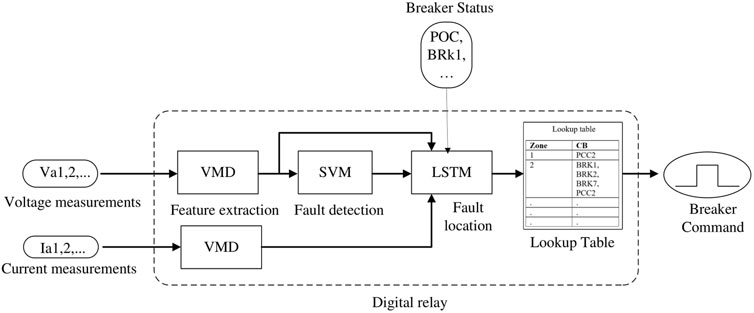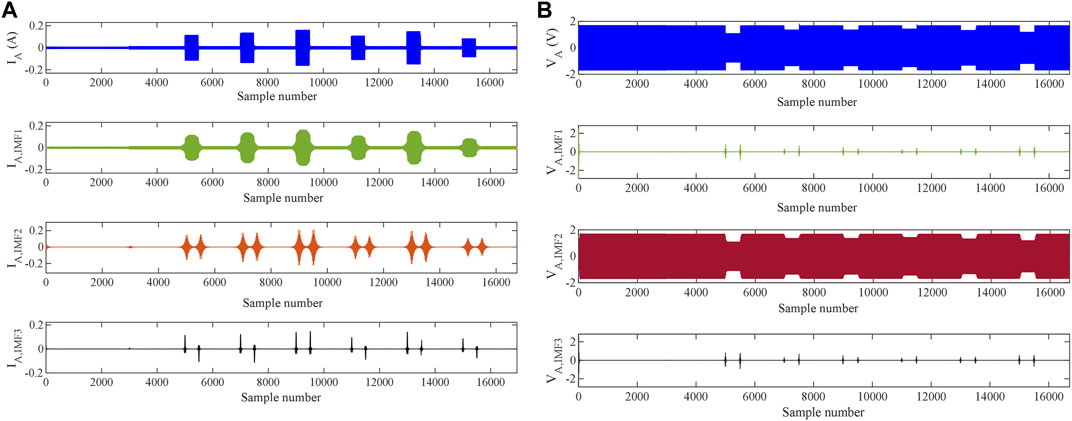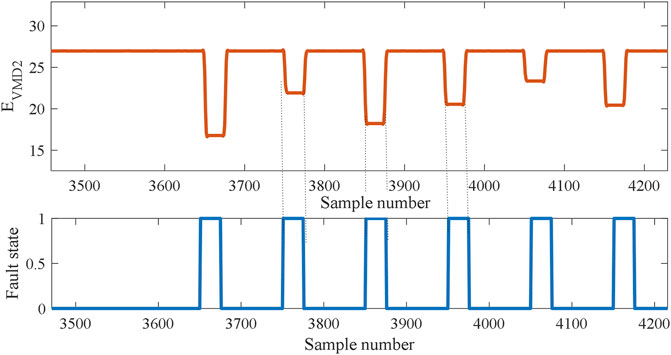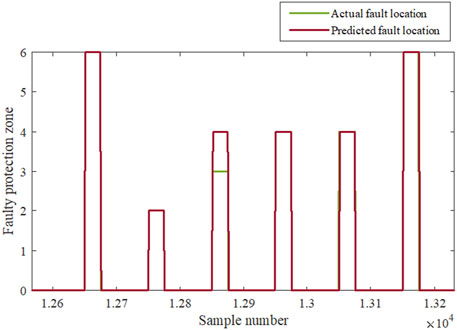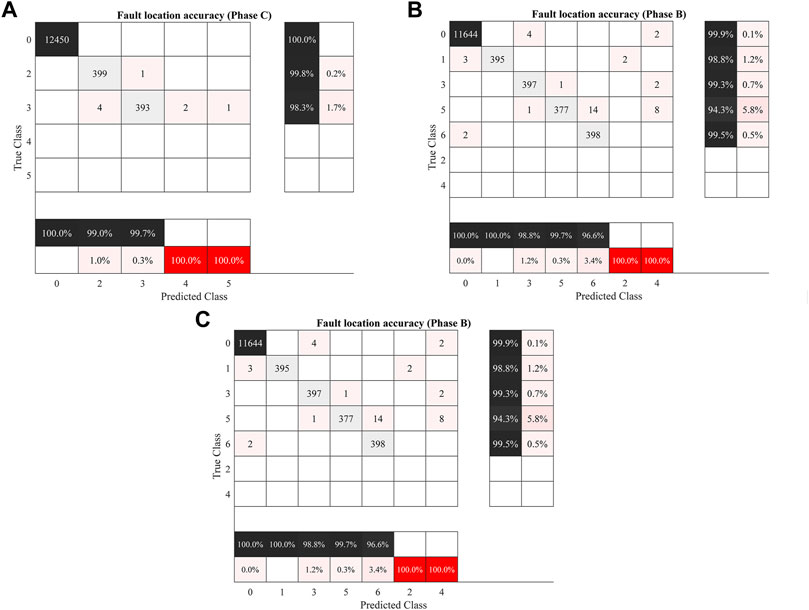- Beijing Etechwin Elec. Co., Ltd./Goldwind Sc. & Tech Co., Ltd., Beijing, China
This article proposes a fault detection and location strategy based on cognitive edge computing to harvest the benefits of cognitive edge computing and address the special needs of active distribution networks (ADNs). In the proposed strategy, an ADN smart gateway is used to compile data in a central repository where it will be processed and analyzed. The intermediary smart gateway includes a protection unit where the fault detection, location, and isolation are accomplished through a combination of virtual mode decomposition (VMD), support vector machine (SVM,) and long short-term memory (LSTM)–type deep machine learning tools. The local measurements of branch currents and bus voltages are processed through VMD, and the informative decomposed components are provided as inputs to the SVM-based fault detection unit and LSTM-based fault location unit. The smart digital relay passes trip commands to the respective circuit breaker/s and submits compiled data regarding the history of faults and protection actions to the upper-level units. The findings from simulation results demonstrate the effectiveness of the proposed strategy to provide fast and accurate fault detection and protection against all types of faults and locations in the ADN.
Introduction
An active distribution network (ADN) is a section of a power system that involves a combination of distributed energy resources (DERs) and flexible network topology. The involvement of various generating units and, especially, renewable energy resources with fluctuating outputs, the possibility of variation in topology during the operation, and other special characteristics of ADNs make their protection relatively complex compared to the conventional distribution networks. Some of the special features in the protection of ADNs are low fault currents from converter-based generators, multiple directions of flow of fault currents, and continuous change of topology leading to complexity in the adjustment of protection setting values. Such special characteristics of ADNs result in the commonly used current magnitude-based protection relays (such as overcurrent protection) being less effective in the case of ADNs (Hooshyar and Iravani, 2017; Hooshyar and Iravani, 2018). Differential protection is seen as a more effective option, especially for the protection of individual units or sections of a power system. However, there comes the economic burden of having individual protection systems for individual units or sections with it. When applied to an ADN with multiple DER units, differential protection with fixed or slightly adjustable (as in percentage/dual-slope differential relays) threshold setting is vulnerable to sensitivity issues due to a varying fault magnitude and the possibility of multiple sources feeding a fault. These issues lead to an increased need for advanced and smarter protection schemes that can cope with the future power system.
One way of achieving the required accurate and effective fault detection and protection is through the use of integrated information in a centralized manner. Features of the Internet of Things (IoT) are being increasingly integrated into the power system, with the concepts of virtual power plant, energy internet, and smart grid becoming more popular. Active distribution networks are part of the smart grid concept. The growing information and communication technology (ICT) capacity in today’s power system allows for the application of cloud computing and edge computing technologies. The use of such tools in the protection systems is compatible with and expected to contribute to ongoing changes in the power system.
A range of techniques is suggested for fault detection and location in active distribution networks and microgrids. The categories, operation, constraints, strength and shortcomings of different protection schemes applicable to distribution networks integrating distributed generation units are highlighted by Nsaif et al. (2021). One of the most popular approaches in fault analysis is the use of symmetrical components, where a three-phase system is converted to three single-phase systems, for positive, negative, and zero sequences. Detailed analysis of symmetrical components fault analysis in active distribution networks is discussed by Mijailović et al. (2018). The article lists four types of distributed generation units (DGs) regarding short circuit modeling and focuses on synchronous generators. The authors argue that synchronous DGs is the most critical DG type in terms of their impact on the fault current. However, the fact that converter-based generators (CBGs) are becoming integral in today’s distribution system means it is important to consider such DGs in the fault analysis. Strezoski and Prica (2016) tried to consider CBGs in the fault analysis of active distribution networks. It is stated that the controllers in converters of those DGs are usually set to inject only positive-sequence currents, even during unsymmetrical faults. This limits the effectiveness of protection schemes based on sequence components other than positive sequence.
Fei and Moses (2019) used a current tracing method based on the SVM model for fault detection of lower-level faults in distribution systems with inverter-based DERs and reported that the method provides sufficient details and sensitivity to identify faults and other abnormal conditions in the distribution feeder. The study focused on modeling and studying a single distribution feeder rather than a complete distribution network. An attempt to use other machine learning–based techniques was presented by Shafiullah et al. (2018) for fault location in distribution grids. They employed the Stockwell transform to extract useful features from recorded three-phase current signals that are used as inputs for the machine learning tools. High impedance faults were not considered in the study.
Another work, by El-Zonkoly (2011), proposed a multi-agent based scheme that uses the entropy of wavelet coefficients of the measured bus currents for fault diagnosis in distribution networks with distributed generators. The study used the sum of absolute entropies of wavelet coefficients of the Clarke components to determine the type of fault. The microprocessor-based protection scheme employs a communication network that allows information on the status of the relays and breakers to be obtained from the supervisory control and data acquisition system. The proposed technique would use the objective comparison of signal features from measurements at the different busbars to locate the faults, which may be difficult at times, especially because the fault currents and impacts on the fault-detection signal features could be varied under different operational conditions.
Features of measured positive-sequence impedance at near and far ends of a protected line section in distribution networks with CBGs are used for protection of internal and external fault cases in work by Xu et al. (2016). Their study devised a strategy based on the amplitude difference of differential impedance with restraining characteristics and a current amplitude difference coefficient. Though the proposed strategy has a greater ability to resist transition resistance compared to the current conventional differential protection, it still gradually loses the advantage with increasing fault resistance, especially for high-impedance faults.
The special challenges in designing protection schemes for a distribution network consisting of microgrids due to the dynamic characteristics in their architecture are also addressed by Habib et al. (2020). The study proposed a centralized approach where operational modes and topologies are monitored for optimal detection and protection of faults. Data distribution service middleware is used to interface the hardware and software environments, and the relay settings are adjusted based on the topology and the shortest path to a fault. While the article is a trailbreaker in its proposed software–hardware infrastructure, the protection scheme while on modified versions of directional and distance relays cannot guarantee resilience against multiple-direction of fault currents and low fault current levels from CBGs.
Protection systems which use communication media are getting wider recognition in recent times to ensure reliable operation of distribution networks. The possible role of communication systems for such purpose are outlined by Habib et al. (2020). A further verification of a similar approach is provided by Cai et al. (2020), who used a technique based on IEC 61850 for protection of distribution networks. The study divided a regional distribution network into protection zones based on the switch status and sampling conditions and represented the protection zones by the zone incidence matrix. The decisions for fault removal operations are established in the same way and denoted as incidence matrix according to the ability of a switch to cut the fault current. The method relies on updating system settings based on communicated status information. The effectiveness of such a method depends on the size and complexity of the distribution network. Large and complicated networks could result in the processing of large and complex information, which would be difficult to implement practically.
Zhang et al. (2019) also proposed an integrated wide-area protection scheme for ADNs based on the fault components principle with a three-level hierarchical structure. Fault detection and classification are performed through the use of a fault state network composed of the pre-fault state and post-fault state networks generated using the superposition principle. The post-fault state network is also composed of positive-sequence, negative-sequence, and zero-sequence fault components networks. The method ignored the influence of line capacitance, which may be significant, especially in the case of ungrounded systems and high impedance faults. The time-delay cooperation-based approach used to realize protection selectivity is reported to ensure the reliability of the protection system while at the same time possibly affecting the speed of the protection system operation, leading to less convenience when the devised technique is used as a primary protection.
Strategies of real-time dispatching and protection for active distribution networks are presented by Song and Caihong (2018). A structure with three layers, consisting of a centralized monitoring layer, an optical fiber network layer, and a terminal nodes layer, is applied. A multi-level protection system with centralized differential protection was suggested as the main protection with backup protections based on multi-stage over-current protection. The enhancement from the conventional differential and overcurrent protections is interesting, although the fact that the basic working principles are still reliant on pre-specified threshold values means the strategies are vulnerable to the possibility of malfunctioning in special events related to changes in configuration and generation status of DGs.
Many studies have investigated the possibility of applying communication systems (Coffele et al., 2015; Singh et al., 2016), signal processing techniques (Bukhari et al., 2017; Netsanet et al., 2018; Wang et al., 2019; Aftab et al., 2020; Xie et al., 2020; Sharma et al., 2021; Wilches-Bernal et al., 2021), and machine learning tools (Orozco-Henao et al., 2018; Silva et al., 2018; Khalaf et al., 2019; Uzair et al., 2019; Peng et al., 2021) in the protection of ADNs and microgrids. Some of the techniques are modifications of the customary protection schemes that require pre-specified relay settings, although some accommodate adaptive modification of the setting values. Those approaches may be too complicated for implementation when the network is large and complex. Using machine learning techniques that can learn the complicated nature of fault conditions under varying network configurations is one of the suggested techniques.
In an article by Xie et al. (2020), a double-ended traveling wave–based fault location method that makes use of VMD and Teager energy operator (TEO) is proposed for distribution networks. A fault distance difference matrix (FDDM) built from TEO analysis on the VMD decomposed signal of the post-fault traveling wave is compared against a pre-fault calculated intrinsic distance difference matrix (IDDM) to locate the fault. The presence of tap points or DGs in ADNs could affect the performance of traveling wave–based fault location techniques (Wilches-Bernal et al., 2021). The VMD-based fault detection technique is also applied for a low-voltage DC microgrid with renewable sources by Sharma et al. (2021). VMD is used with Teager-Kaiser energy operators (TKEOs) to calculate time entropy values from transient zero-sequence currents that are used as input to identify a high impedance fault from the capacitor and load switching in distribution network in a 2019 article by Wang et al.
A study by Peng et al. (2021) utilized a radial basis function neural network for fault location in a distribution network with homogenous and hybrid feeders. Although the issue of homogeneity in feeder types is an important aspect of protecting distribution networks, the more concerning aspect of the existence of multiple DERs in the contemporary distribution networks is not addressed. However, the article outlined the possibility of using edge computing tools for different aspects of power system protection. The application of edge computing in relay protection is discussed by Yin et al. in their 2019 study. However, details of the technique are not presented, aside for a brief mention that time series, regression analysis, and expert system methods are used. Another study, by Huo et al. (2020), also tried to apply edge computing for fault diagnosis and location in low-voltage power systems. It states that the method involves Wavelet analysis (singular signal detection, signal-to-noise separation, and frequency band analysis). However, discussions on how to set the threshold value for fault detection and how the faults are located are not provided. These are the challenging aspects in fixed setting protection schemes and protection systems that depend on an analytical comparison of some parameters.
One factor to pay attention to in the application of machine learning–based approaches is whether the models are capable of learning and representing both the long-term and short-term relationships between factors and the fault conditions. The use of signal-processing tools to extract features from the measured voltage and current signals is suggested to improve the performance of machine learning–based techniques. Wavelet transform and Hilbert transform are the most commonly used techniques. Those techniques may be effective to some extent, while the latest methods, such as VMD, are better in terms of proving information on both amplitude and frequency and being robust in terms of sampling and noise.
The proposed method of fault detection and protection in this study involves a virtual mode decomposition (VMD)-based signal analysis stage where the measured voltage and current waveforms are preprocessed to produce decomposed components, which can better show the discontinuity in the waveforms and hence be better used as inputs for fault detection and location. The decomposed components are provided as inputs first to the SVM-based fault detection module and then to the Long Short-Term Memory (LSTM) model, which is trained to identify the faulted zone. Each of the three phases is treated individually, and the judgment on the type of fault is made through analysis of each. The decision as to whether the circuit breaker will open is hence based on the results from fault detection and location units of each phase. The devised strategy is tested based on a PSCAD/EMTDS simulation model of a low-voltage ADN consisting of multiple converter-based generators, renewable resources, and clusters of loads. A complete architecture of the overall cloud computing platform that integrates the cognitive edge computing–based digital relay is provided. The digital relay design is also provided and constituting modules are developed. The method proved to be effective in terms of detecting and locating all types of faults, high impedance faults, and faults at the different points in the ADN. The article proposes a method of extracting signals for fault detection and location based on VMD opening up to the possibility of using VMD in power system protection studies. The devised protection scheme is also unique in its two-stage approach, where two different types of machine learning tools (SVM and LSTM) employ their best strengths in fault detection and location. The method is different from the fixed (or slightly varying) setting-based protection schemes, because the way the classification problems of fault detection and location are solved through SVM and LSTM models is based on artificial learning of the system architecture and electrical parameters under various conditions rather than analytical comparisons. This allows the devised method to effectively address the issues tied to protecting active networks due to fluctuating and intermittent distributed generation.
The remainder of this article is organized in such a way that the second section discusses the concepts of edge computing, cognitive computing, and digital relay based on cognitive edge computing. The data and method used in the article are discussed in the third section, which is followed by the results and discussion section. The final section provides conclusions on the findings of the study.
Cognitive Edge Computing for Digital Relay
Cognitive computing represents self-learning systems that work on deep learning algorithms and big data analytics to be applied in automated IT models and end-user devices. Internet of Things (IoT) and cloud computing have become an integral part of the different sectors in the world. The power system has also started to move in a similar direction with the incorporation of such features. However, as cloud computing would need larger time delays due to communication and a larger size of data, it would be less suited for protection systems that require fast response time. However, in the case of edge computing, the data analytics and computation tasks happen directly on the devices to which the sensors are connected rather than on the centralized cloud server. Thus, it would be more appropriate for application in the protection system of an ADN. There are some attempts to apply edge computing in power system protection. Sang et al. (2021) applied optimized simulated annealing algorithm (OSAA)-based edge computing for extraction of the forward and reverse traveling waves for relay protection of intelligent substations. Potential applications of machine learning techniques in protection and dynamic security assurance of distribution systems are also reviewed by Aminifar et al. (2021).
A typical edge computing relay-based protection structure is shown in Figure 1. The architecture involves different layers. The first layer is where the sensors or meters are located. There will also be devices that will collect the sensed or measured information and may perform simple operations such as opening and closing circuit breakers. The intermediary layer, called the edge node, is where the actual data processing and computations of fault detection and location will be performed. The upper layer, called the cloud, includes cloud services where higher-level computation on the utility grid level may be performed. This includes big data analytics and processing, presentation of compiled information and decision making on recalibration of protection system, or changes to the lookup table in cases where the system architecture is significantly altered.
The edge computing–based digital relay proposed in this study involves the use of cognitive tools such as support vector machine (SVM) and a deep learning tool called long short-term memory (LSTM) network for detection and location of faults respectively. Edge computing tools have the advantages of higher speed, reliability, and being economical due to the fact that the devices are located close to the terminal units or the user-end.
Data and Methods
Generation of Data for Training and Testing
The devised fault detection and protection technique is tested based on an active distribution network shown in Figure 2. The ADN is intentionally made to comprise converter-based generators and renewable resources. The main components of the ADN are the utility grid and the other components specified in Table 1.
The data for training and testing the devised method is generated from the recording of the voltage at each busbar and the current in each branch of the circuit shown in Figure 2. The set of disturbances and faults summarized applied for generating the training data are
1. DG switching (ON and OFF)
2. Changing the reference settings for PQ mode DGs
3. Load switching (ON and OFF)
4. Changing the load values
5. Faults in each of the protection zones
6. All types of faults (LG, LL, 2LG, 3L, 3LG)
The fault resistance is taken to be 10Ω. The pseudocode presented in Figure 3 shows the procedure followed in deciding the sequence of events used for generating the training and testing data. The testing data is generated by randomly permuting the order of events applied for the generation of the training data. The type of faults, regarding the phases involved in the fault, are also randomly changed to be different from that of the training data.
Each phase of the three-phase branch currents and busbar voltages are sampled with with a sampling frequency of 1 kHz. The fault locations and faulty sections as well as the different disturbances are also recorded for future use to train the LSTM-based fault detection model.
Variational Mode Decomposition Based Feature Extraction
The use of signal processing techniques is becoming a customary practice in digital protection relay studies. The signal processing tools such as Wavelet transform, Fourier transform, Hilbert transform, and mode decomposition techniques are used to extract features from the measured current and voltage. Those extracted signal features are expected to be more informative than the original signals to detect and locate faults.
Variational mode decomposition (VMD) is one of the signal decomposition techniques that has become more popular in recent years after being proposed in 2014 by Dragomiretskiy and Zosso (Dragomiretskiy and Zosso, 2014). VMD decomposes a parent signal into an ensemble of modes and their respective center frequencies. For an original current or voltage signal of f(t), the VMD decomposition into K components called “intrinsic mode functions” (IMFs) can be expressed as
where uk(t) are the decomposed components or IMFs, which will have a cosine function waveform and slowly varying and positive envelopes. Each of the decomposed IMFs have instantaneous frequencies that vary slowly in a nondecreasing pattern and are concentrated around a central frequency wk.
The VMD procedure can be summarized into the following three steps:
1. Hilbert transform: To acquire the unilateral frequency spectrum (δ(t)+(j/πt)) p uk(t) for is extracted each mode uk using Hilbert transform
2. Frequency mixing: An exponential term is added to the analysis signal of each mode to adjust its estimated center frequency and the spectrum of each mode modulated to the corresponding base frequency band [(δ(t) + (j/πt)) ∗ uk(t)]e−jωkt.
3. Heterodyne demodulation: The gradient squared L2 bound norm of the demodulation signal is calculated, and the signal bandwidth of each mode is estimated.
The core process involved in VMD is finding a discrete set of IMFs uk(t) with respective central frequencies wk(t) that minimize the constrained variational problem defined by Eq. 2 (Dragomiretskiy and Zosso, 2014):
where δ is the Dirac function,
The minimization problem can be solved as the saddle point of the augmented Lagrangian
The equations are transformed from time domain to frequency domain, whose quadratic optimization final solutions are given as
where ˆ = Fourier transform, n = iteration number.
In this article, the busbar voltages and branch currents are measured and processed though VMD to generate the features to be used for fault detection and location. The fault detection is based on voltage features, while both voltage and current features are used together with other variables for the fault location procedure. The feature extraction procedure involves applying VMD on the measured voltage and current signals first. The number of IMFs to be extracted is an important parameter. Though repeated attempts, it was observed that a large number of IMFs would result in noisy and less informative IMFs, while the opposite would cause missing of informative IMFs. The number of IMFs is finally decided to be three. The details of the VMD applied are shown in Table 2.
After decomposing the voltage and current signals, the IMFs with better information for detecting and locating faults are identified through visual inspection. As a result, the first IMF of the current signals and the second IMF of the voltage signals are used. The next step is calculating the total energy in each cycle for the VMD decomposed components using Frobenius norm as in equation.
where EVMD,i is the energy for ith IMF of a signal (voltage or current) for a cycle, VMDi is the ith IMF, and N is the number of data points in a cycle (20 in our case). The procedure followed in extracting features for fault detection and location using VMD is summarized in Figure 4.
Support Vector Machine Based Fault Detection
Support vector machines are one of the machine learning tools that are applicable for classification and regression analysis tasks. SVM is a non-probabilistic binary linear classifier. SVM has the advantage of being memory efficient and versatile.
In SVM algorithm, each data item is plotted as a point in n-dimensional space (where n represents the number of features in the data) with the value of each feature being the value of a particular coordinate. The classification is then performed by searching for an optimal hyperplane that can separate the dataset into two classes though maximizing the space that does not contain any observations. For a linear SVM score function of the form f(x) = x′β+b with x representing the observations, β being the coefficients vector and b being the bias term, the root of function f(x) for particular coefficients defines a hyperplane, and the SVM algorithm searches for the maximum margin length. The algorithm uses the Lagrange multipliers method for the optimization, which are intended to minimize the term in Eq. 8:
with respect to the n coefficients α1, α2...,αn subject to
An SVM model for two-class classification supports mapping the predictor data—in our case, the features extracted from the busbar voltage signals using kernel functions—and supports sequential minimal optimization for objective-function minimization. The general algorithm for such a two-class learning with cost matrix Г is updating the class prior probabilities p to pc by incorporating the penalties described in Г.
The SVM model used in this study for the fault detection procedure uses Sequential Minimal Optimization (SMO) solver and a linear Kernel function. The outlier fraction is set to be zero, as there are no expected outlier observations in the training set. The observation data points are given equal weights, with the vector of observation weights set as a vector of ones with the size of the vector equal to the length of the input data.
LSTM-Based Fault Location
The later stage of the methodology, which locates the faulty zone, deploys a deep learning network that learns features of the VMD decomposed current and voltage signals. The specific technique used is a Long Short-Term Memory (LSTM) network. It is a type of recurrent neural network (RNN), which works well with sequence and time-series data because of its capability to learn long-term dependencies between time steps of sequence data. The fact that these recurrent networks possess a certain type of memory makes them analogous with the memory system in the human brain.
The computations in LSTM networks involve simple algebraic equations, unlike the intelligence in its overall learning capability, which allows fast computation speed and also makes the method suitable for real-time application. LSTM networks were first introduced by Hochreiter and Schmidhuber (1997) and have since been modified considerably through the contributions of many. The algorithm has become popular due to its capability to avoid the vanishing gradient issue in RNNs, where influence of a given input decays exponentially as it cycles around the network’s recurrent connections. This feature allows LSTM networks to store and access information over long periods of time. Figure 5 shows the general structure of an LSTM network where f, g, h are non-linearity functions. Table 2 presents the description of parameters of the LSTM network used for fault location in this article.
Devised Protection Scheme and Procedures
The method applied in this article involves the steps shown in Figure 6. The first step is modeling the ADN using PSCAD/EMTDS software and generating the data for training and testing of the devised fault detection scheme. The later stage involves virtual mode decomposition of the collected current and voltage records. In the next step, SVM and LSTM models are developed for fault detection and location. An SVM model and an LSTM network are trained for each phase using the features extracted from the VMD decomposition. The trained models are tested based on data generated from different sets of events. The steps are discussed in detail in this section.
The first stage of microgrid protection, which is fault detection, is carried out using the SVM model. The scheme is selected for its effectiveness in mapping more than one input parameter to a binary classification variable, which in our case is the existence or absence of fault in the ADN. Each phase has one SVM model, and the inputs for the model are the VMD decomposed components of the busbar voltages.
After the decision regarding occurrence of fault is made using the SVM models, the location of the faults is evaluated using an LSTM network which is one of the deep learning tools. The VMD decomposed features of branch currents and bus voltages, the status of circuit breakers, and the output of the SVM fault detection model are trained against the location of faults using the LSTM network. The choice of LSTM network or generally recurrent neural network is traced to the capability of the scheme to handle multi-dimensional time-sequence data for classification applications. More than one parameter exists in an observation, making the input parameter multi-dimensional, so other methods such as SVM or ANFIS would not be capable of dealing with it as an LSTM network would. The structure of the designed cognitive edge computing based digital protection relay is shown in Figure 7. The sequence of operation of the relay and the circuit breakers starts with the fault detection step, and the state of the microgrid is judged as faulty or not based on the extracted voltage and current features. Once a fault is detected, the faulted zone is identified by the fault location component and the zones are translated into the respective circuit breaker/s that need to be opened based on a lookup table.
The fault detection and location algorithms require features of the measured voltage and current extracted by VMD. Thus, a 20-data-point (equivalent to one cycle) measurement is required to initiate the protection action. There could also be an additional intentionally added delay that determines whether the incident has sustained for a specified number of sample points to avoid false tripping. However, such a delay, and the physical and communication related latencies, are not considered in this study. Aside from such delays, the fault detection and location are performed in real time.
In order to evaluate the performance of the devised fault detection scheme in this study, the confusion matrix and accuracy measures of f-score, recall, and precision parameters are used as defined by Fei and Moses (2019). The parameters are expressed in percentage forms in the following equations:
where TP = true positive, FP = false positive, TN = true negative, and FN = false negative.
F-score is a convenient way to show the performance of such a classification model. The correctness of the model relies on estimating positives more than on estimating negatives, because faults are the concern here. The system is going to be operating normally with no fault (which means “negative”) for most of the time. Thus, evaluating the performance of the model for both positives and negatives together (assessing the very large number of “true negatives”) would give an exaggerated measure of accuracy. F-score, on the other hand, allows the performance of the model to be evaluated more critically.
Accuracy of the fault location model is evaluated using a confusion chart and respective accuracies of the classification for each protection zone using the following equation:
where Pred_Loc = predicted location (zone) and Act_Loc = actual location (zone).
Results and Discussion
VMD Decomposition Results
The first important stage in the devised protection scheme is the extraction of features for fault detection and location using VMD decomposition. The decomposition assists in extracting features of the measured voltage and current signals, which can provide information for the detection and location of faults (Figure 8).
Fault Detection Results
The fault detection procedure based on SVM binary classification is tested based on the test data set generated by applying the disturbances mentioned in 3.1. The energies of VMD decomposed components of the five busbars in the ADN are used as input in the fault detection module of the protection system (see Figure 9).
Individual SVM models are used to detect faults in each of the phases. The receiver operating characteristic (ROC) of the SVM classifier, which is 0.978, indicates the developed model is a perfect classifier and hence a perfect fault detector. The models were able to detect all kinds of (both balanced and unbalanced) faults with 100% precision, as shown in Table 3. The F-score measure also shows that each of the phase fault detection models have F-score values of around 98%. Only a few points were observed to create confusion in the fault detection model. It is also important to note that there is no “false positive” in the results (Table 3). Thus, the confusion will not cause any false tripping of breakers. The only few “false negative” points occurred at the ends of the faults, as shown in Table 3 and Figure 10. This is nothing but the protection system signaling a reclose order to the circuit breaker just one cycle before actual fault clearing. This can be addressed with a delay feature that waits to see if the fault detection signal persists for a few more time steps. The output of the fault detection module is provided to the fault location module, whose results are discussed next.
Fault Location Results
The fault location model is based on an LSTM network. Energies of the VMD decomposed components of the branch currents and bus voltages are supplied as input together with the status of the circuit breakers and output of the fault detection module. As with the fault detection procedure, individual LSTM networks are trained for each phase. The accuracy of the network at the end of the training is close to 100%.
The LSTM network was able to locate the faults with 100% accuracy. Figure 11 shows the result of the fault location testing. Because the actual fault location and the location estimated by the LSTM network perfectly fit with each other, the graphs would normally overlap and only one color would be visible for most of the simulation period. In the Figure 11, we intentionally picked the time zone with an error in locating the fault so that both lines could be noted. As the Figure 12A–C shows, the fault location model using LSTM networks were able to locate the faults with an accuracy of more than 99%. In the few points where the fault location model mislocated the faults, the estimated zone is seen to be a neighboring one to the actual faulted zone. Hence, the very few erroneous results will simply result in the isolation of a neighboring zone.
After the faults are detected and located through the fault detection and location units, the appropriate fault clearing action will be carried out through a breaker opening command that can be generated based on a lookup table that associates the protection zones with the circuit breakers.
Conclusion
This article discusses the development of a cognitive edge computing–based digital relay for the protection of a low voltage ADN. The devised relay is based on an architecture composed of three layers: a lower-level sensor and measurement type layer; a second layer with edge nodes where the cognitive computing-based fault detection and location are undertaken; and the top layer – i.e., the cloud – where the information from the edge nodes are compiled and further processed. The cognitive edge computing–based relay comprises a fault detection module and a fault location module. The fault detection is achieved through an SVM-based model, while the later uses an LSTM network.
The effectiveness of the devised fault detection and location techniques are verified based on test data generated using an ADN test model simulated in PSCAD-EMTDS. The proposed methods were proven to be effective in addressing the challenges specific to ADNs and general protection issues related to high impedance faults. The fault detection unit of the relay was able to identify diverse fault types based on the features of the voltage extracted by VMD decomposition. The fault detection unit was effective in detecting myriad types of faults; only a very few false negatives occurred at the en of very few fault events. Although this has no significant impact on the protection system, it may be served better by backup protection or if the method is used as a backup. The LSTM-based fault location unit used the features extracted from the bus voltage and branch currents as well as the status of the breakers and the output of the fault detection unit as inputs. It also performed at close to 100% accuracy in locating all types of faults in the ADN. The technique is advantageous in that adaptive adjustment of protection relay settings is not needed and the complex fault conditions related to the plug and play features of an ADN and the generation variation from renewable DGs are learned easily by the LSTM and SVM models and the relay was able to respond properly under varying conditions of generation and loading. The proposed method has proven effective under various arrangements within the ADN with components taken out and brought back to the network. However, the models used for fault detection and location need to be trained again in cases where new components are added to the network or the architecture is altered significantly.
Data Availability Statement
The raw data supporting the conclusions of this article will be made available by the authors without undue reservation.
Author Contributions
SN was responsible for the conceptualization, PSCAD modeling, methodology, and MATLAB coding, draft preparation; DZ, for the formal analysis and project administration; ZW, for the resources and data curation; and GT, for the review and editing. All authors have read and agreed to the published version of the manuscript.
Conflict of Interest
Authors SN, DZ, ZW, and GT were employed by Beijing Etechwin Elec. Co., Ltd/Goldwind Sc. & Tech Co., Ltd.
Publisher’s Note
All claims expressed in this article are solely those of the authors and do not necessarily represent those of their affiliated organizations or those of the publisher, the editors, or the reviewers. Any product that may be evaluated in this article or any claim that may be made by its manufacturer is not guaranteed or endorsed by the publisher.
Acknowledgments
The authors would like to thank Goldwind Sc. & Tech. Co, Ltd. for providing the necessary data and platform to undertake this research.
Supplementary Material
The Supplementary Material for this article can be found online at https://www.frontiersin.org/articles/10.3389/fenrg.2022.826915/full#supplementary-material.
References
Aftab, M. A., Hussain, S. M. S., Ali, I., and Ustun, T. S. (2020). Dynamic Protection of Power Systems with High Penetration of Renewables: A Review of the Traveling Wave Based Fault Location Techniques. Int. J. Electr. Power Energy Syst. 114, 105410. doi:10.1016/j.ijepes.2019.105410
Aminifar, F., Teimourzadeh, S., Shahsavari, A., Savaghebi, M., and Golsorkhi, M. S. (2021). Machine Learning for Protection of Distribution Networks and Power Electronics-Interfaced Systems. Electr. J. 34, 106886. doi:10.1016/j.tej.2020.106886
Bukhari, S. B. A., Saeed Uz Zaman, M., Haider, R., Oh, Y.-S., and Kim, C.-H. (2017). A Protection Scheme for Microgrid with Multiple Distributed Generations Using Superimposed Reactive Energy. Int. J. Electr. Power Energy Syst. 92, 156–166. doi:10.1016/j.ijepes.2017.05.003
Cai, Y., Cai, Z., Liu, P., Li, X., and Dai, G. (2020). Communication-Assisted Protection and Self-Healing Control Scheme for Distribution Networks Based on IEC 61850. IEEE Access 8, 72169–72178. doi:10.1109/ACCESS.2020.2987921
Coffele, F., Booth, C., and Dysko, A. (2015). An Adaptive Overcurrent Protection Scheme for Distribution Networks. IEEE Trans. Power Deliv. 30, 561–568. doi:10.1109/TPWRD.2013.2294879
Dragomiretskiy, K., and Zosso, D. (2014). Variational Mode Decomposition. IEEE Trans. Signal Process. 62, 531–544. doi:10.1109/TSP.2013.2288675
El-Zonkoly, A. M. (2011). Fault Diagnosis in Distribution Networks with Distributed Generation. Electr. Power Syst. Res. 81, 1482–1490. doi:10.1016/j.epsr.2011.02.013
Fei, W., and Moses, P. (2019). Fault Current Tracing and Identification via Machine Learning Considering Distributed Energy Resources in Distribution Networks. Energies 12, 4333. doi:10.3390/en12224333
Habib, H. F., Fawzy, N., Esfahani, M. M., Mohammed, O. A., and Brahma, S. (2020). An Enhancement of Protection Strategy for Distribution Network Using the Communication Protocols. IEEE Trans. Ind. Appl. 56, 1240–1249. doi:10.1109/TIA.2020.2964638
Hochreiter, S., and Schmidhuber, J. (1997). Long Short-term Memory. Neural Comput. 9 (8), 1735–1780. doi:10.1162/neco.1997.9.8.1735
Hooshyar, A., and Iravani, R. (2018). A New Directional Element for Microgrid Protection. IEEE Trans. Smart Grid 9, 6862–6876. doi:10.1109/TSG.2017.2727400
Hooshyar, A., and Iravani, R. (2017). Microgrid Protection. Proc. IEEE 105, 1332–1353. doi:10.1109/JPROC.2017.2669342
Huo, W., Liu, F., Wang, L., Jin, Y., and Wang, L. (2020). Research on Distributed Power Distribution Fault Detection Based on Edge Computing. IEEE Access 8, 24643–24652. doi:10.1109/ACCESS.2019.2962176
Khalaf, A., Hassan, H. A. A., Emes, A., Akcakaya, M., and Grainger, B. M. (2019). “A Machine Learning Approach for Classifying Faults in Microgrids Using Wavelet Decomposition,” in IEEE International Workshop on Machine Learning for Signal Processing, MLSP, Pittsburgh, PA, USA, 13-16 October 2019. doi:10.1109/MLSP.2019.8918774
Mijailović, V., Ćetenović, D., Ranković, A., Petrović, P., and Rozgić, D. (2018). Analysis of Faults in Active Distribution Network with and without Synchronous Generator Using Instantaneous Symmetrical Components in Time Domain. Electr. Eng. 100 (3), 2117–2127. doi:10.1007/s00202-018-0689-5
Netsanet, S., Zhang, J., and Zheng, D. (2018). Bagged Decision Trees Based Scheme of Microgrid Protection Using Windowed Fast Fourier and Wavelet Transforms. Electronics 7 (5), 61. doi:10.3390/electronics7050061
Nsaif, Y. M., Hossain Lipu, M. S., Ayob, A., Yusof, Y., and Hussain, A. (2021). Fault Detection and Protection Schemes for Distributed Generation Integrated to Distribution Network: Challenges and Suggestions. IEEE Access 9, 142693–142717. doi:10.1109/ACCESS.2021.3121087
Orozco-Henao, C., Suman Bretas, A., Marín-Quintero, J., Herrera-Orozco, A., Pulgarín-Rivera, J., and Velez, J. (2018). Adaptive Impedance-Based Fault Location Algorithm for Active Distribution Networks. Appl. Sci. 8, 1563. doi:10.3390/app8091563
Peng, N., Liang, R., Wang, G., Sun, P., Chen, C., and Hou, T. (2021). Edge Computing-Based Fault Location in Distribution Networks by Using Asynchronous Transient Amplitudes at Limited Nodes. IEEE Trans. Smart Grid 12 (1), 574–588. doi:10.1109/TSG.2020.3009005
Sang, Z., Yang, K., and Zhang, R. (2021). A Security Technology of Power Relay Using Edge Computing. PLoS One 16, e0253428. doi:10.1371/journal.pone.0253428
Shafiullah, M., Abido, M., and Abdel-Fattah, T. (2018). Distribution Grids Fault Location Employing ST Based Optimized Machine Learning Approach. Energies 11, 2328. doi:10.3390/en11092328
Sharma, N. K., Samantaray, S. R., and Bhende, C. N. (2021). VMD-Enabled Current-Based Fast Fault Detection Scheme for DC Microgrid. IEEE Syst. J. 16, 933–944. doi:10.1109/JSYST.2021.3057334
Silva, S., Costa, P., Gouvea, M., Lacerda, A., Alves, F., and Leite, D. (2018). High Impedance Fault Detection in Power Distribution Systems Using Wavelet Transform and Evolving Neural Network. Electr. Power Syst. Res. 154, 474–483. doi:10.1016/j.epsr.2017.08.039
Singh, M., Vishnuvardhan, T., and Srivani, S. G. (2016). Adaptive Protection Coordination Scheme for Power Networks under Penetration of Distributed Energy Resources. IET Gener. Transm. Distrib. 10, 3919–3929. doi:10.1049/iet-gtd.2016.0614
Song, Z., and Caihong, Y. (2018). “Research on Strategies of Real-Time Dispatching and Protection of Active Distribution Network,” in 2018 China International Conference on Electricity Distribution (CICED) (Tianjin, China: IEEE), 1787–1791. doi:10.1109/CICED.2018.8592520
Strezoski, L. V., and Prica, M. D. (2016). “Real-Time Short-Circuit Analysis of Active Distribution Systems,” in 2016 IEEE Power and Energy Conference at Illinois, Urbana, IL, USA, 19-20 February 2016. PECI 2016. doi:10.1109/PECI.2016.7459252
Uzair, M., Li, L., Zhu, J. G., and Eskandari, M. (2019). “A Protection Scheme for AC Microgrids Based on Multi-Agent System Combined with Machine Learning,” in 2019 29th Australasian Universities Power Engineering Conference, Nadi, Fiji, 26-29 November 2019. AUPEC 2019. doi:10.1109/AUPEC48547.2019.211845
Wang, X., Gao, J., Wei, X., Song, G., Wu, L., Liu, J., et al. (2019). High Impedance Fault Detection Method Based on Variational Mode Decomposition and Teager-Kaiser Energy Operators for Distribution Network. IEEE Trans. Smart Grid 10, 6041–6054. doi:10.1109/TSG.2019.2895634
Wilches-Bernal, F., Bidram, A., Reno, M. J., Hernandez-Alvidrez, J., Barba, P., Reimer, B., et al. (2021). A Survey of Traveling Wave Protection Schemes in Electric Power Systems. IEEE Access 9, 72949–72969. doi:10.1109/ACCESS.2021.3080234
Xie, L., Luo, L., Li, Y., Zhang, Y., and Cao, Y. (2020). A Traveling Wave-Based Fault Location Method Employing VMD-TEO for Distribution Network. IEEE Trans. Power Deliv. 35, 1987–1998. doi:10.1109/TPWRD.2019.2959188
Xu, M., Zou, G., Xu, C., Sun, W., and Mu, S. (2016). “Positive Sequence Differential Impedance Protection for Distribution Network with IBDGs,” in 2016 IEEE International Conference on Power System Technology, Wollongong, NSW, Australia, 28 September 2016 - 01 October 2016. POWERCON 2016. doi:10.1109/POWERCON.2016.7753871
Yin, Y., Jiang, Y., Wen, H., Zhang, Y., Ming, Z., and Lei, W. (2019). “Relay Protection Based on Edge Computing in Power System,” in 2019 International Conference on Energy, Power, Environment and Computer Application (ICEPECA 2019) (Wuhan, China: DEStech Publications). doi:10.12783/dteees/icepe2019/28913
Keywords: active distribution network, edge computing, cognitive computing, fault detection, fault location
Citation: Netsanet S, Zheng D, Wei Z and Teshager G (2022) Cognitive Edge Computing–Based Fault Detection and Location Strategy for Active Distribution Networks. Front. Energy Res. 10:826915. doi: 10.3389/fenrg.2022.826915
Received: 01 December 2021; Accepted: 06 June 2022;
Published: 10 August 2022.
Edited by:
Jun Liu, Xi’an Jiaotong University, ChinaReviewed by:
Kenneth E. Okedu, National University of Science and Technology (Muscat), OmanCheng Qian, First Affiliated Hospital of Zhengzhou University, China
Copyright © 2022 Netsanet, Zheng, Wei and Teshager. This is an open-access article distributed under the terms of the Creative Commons Attribution License (CC BY). The use, distribution or reproduction in other forums is permitted, provided the original author(s) and the copyright owner(s) are credited and that the original publication in this journal is cited, in accordance with accepted academic practice. No use, distribution or reproduction is permitted which does not comply with these terms.
*Correspondence: Solomon Netsanet, c29sMTRuZXRAeWFob28uY29t
 Solomon Netsanet
Solomon Netsanet Dehua Zheng
Dehua Zheng